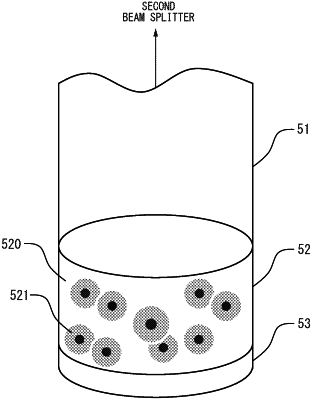| CPC G01R 33/0322 (2013.01) [G02F 1/092 (2013.01)] | 5 Claims |

|
1. An interference type optical magnetic field sensor device comprising:
a light emitter emitting first linearly polarized light;
a first optical element receiving the first linearly polarized light, and forming polarized-plane-rotated light including a first linearly polarized wave and a second linearly polarized wave orthogonal to the first linearly polarized wave, from the received first linearly polarized light by rotating a polarized plane of the first linearly polarized light and outputting the polarized-plane-rotated light;
a first beam splitter receiving the polarized-plane-rotated light;
a first optical path connected to the first beam splitter;
a second optical path connected to the first beam splitter;
a second beam splitter connected to the first optical path and the second optical path;
a magnetic field sensor element to be disposed within a magnetic field, which is connected to the second beam splitter, wherein a Faraday rotation angle is shifted in response to the magnetic field applied to the magnetic field sensor element; and
a detection signal generator outputting a detection signal,
wherein the first optical element forms the polarized-plane-rotated light from the first linearly polarized light emitted from the light emitter, and outputs the polarized-plane-rotated light to the first beam splitter,
the first beam splitter receives the polarized-plane-rotated light, and separates the received polarized-plane-rotated light into the first linearly polarized wave and the second linearly polarized wave, transmits the first linearly polarized wave to the first optical path so that the first linearly polarized wave propagates in the first optical path, and transmits the second linearly polarized wave to the second optical path so that the second linearly polarized wave propagates in the second optical path,
the second beam splitter receives the first linearly polarized wave and the second linearly polarized wave, and transmits the first linearly polarized wave and the second linearly polarized wave, to the magnetic field sensor element,
the magnetic field sensor element receives the first linearly polarized wave and the second linearly polarized wave, in which a Faraday rotation angle of the received first linearly polarized wave is shifted by the magnetic field applied to the magnetic field sensor thereby forming a third linearly polarized wave, and a Faraday rotation angle of the received second linearly polarized wave is shifted by the magnetic field applied to the magnetic field sensor thereby forming a fourth linearly polarized wave, and outputs the third linearly polarized wave and the fourth polarized wave to the second beam splitter,
the second beam splitter receiving the third linearly polarized wave and the fourth linearly polarized wave and transmits the third linearly polarized wave to the second optical path so that the third linearly polarized wave propagates in the second optical path and transmits the fourth linearly polarized wave to the first optical path so that the fourth linearly polarized wave propagates in the first optical path,
the first beam splitter receives the third linearly polarized wave and the fourth linearly polarized wave, forms a multiplexing wave from the third linearly polarized wave and the fourth linearly polarized wave and transmits the multiplexing wave to the first optical element,
the first optical element receives the multiplexing wave from the first beam splitter, and forms a second linearly polarized light from the multiplexing wave, and outputs the second linearly polarized light to the detection signal generator, and
the detection signal generator receives the second linearly polarized light and outputs the detection signal formed by separating the received second linearly polarized light into an S polarization component and a P polarization component, and converting the S polarization component and the P polarization component into an electric signal.
|